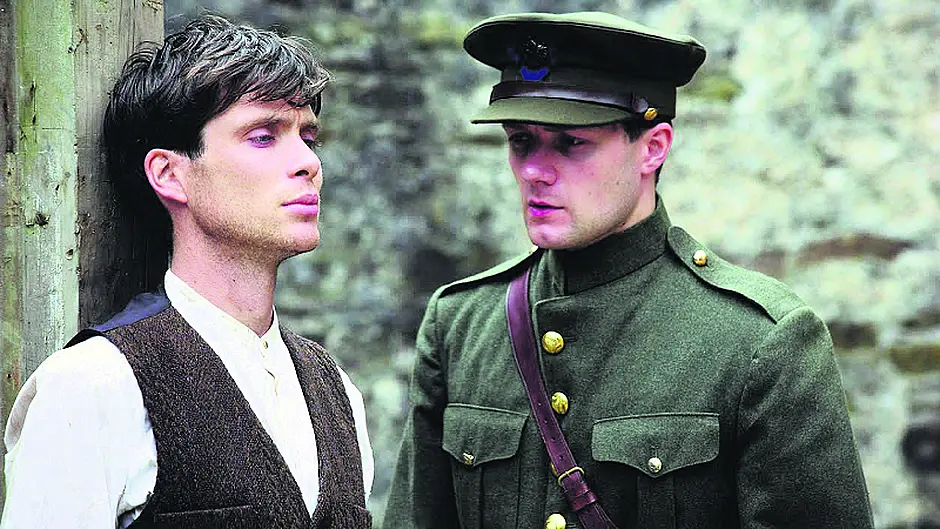A decade on from its release, Kieran O’Mahony talks to those who were involved in the making of the award-winning film
IT is ten years since director Ken Loach’s movie of the Irish freedom struggle, The Wind that Shakes the Barley, was released in cinemas.
Filmed in West Cork in the hot summer of 2005, it brought big name stars and a bit of Hollywood glamour to several towns and villages along the way.
For Cork-born actress Orla Fitzgerald, the fact the movie was being shot in her home county was a double bonus. She even got to get her mum onto the set.
‘The weather held up, which was great, over the eight weeks and it was stunning to be filming in such nice areas of West Cork. My mother came down to the set one day with her friends, and they even got to be extras for the day. Although they didn’t make the final cut, they got dressed up and enjoyed the experience,’ said Orla, who played Sinéad Ní Shúilleabháin in the film.
‘The whole experience was gorgeous and I was home for the summer too, which was great. I knew some of the actors before, so it was like hanging out with my mates for the summer in some regards.’
Working with Ken Loach also proved to be a career highlight for the London-based actress.
‘Ken is just the loveliest man ever, and he sets up such a good environment for an actor and it’s all catered for you to give your best performance.
‘While there is a script, Ken shoots everything in sequence so sometimes you know what’s happening and sometimes you don’t. You may not be in on it, but the other actors are. It’s that element of surprise, so he wants you to get your instinctive reaction to situations.
‘He never called “Action”, he would just say “Whenever you’re ready”, and everybody respected that.’
However, Orla did find the filming emotionally draining, and she even broke down in tears on several occasions – such was the intensity of the experience.
‘We never knew who would be killed in the film and we were all on edge every day, wondering would it be our turn, which added to the that intensity. It wasn’t easy filming it, but the fun off-camera was great,’ she added.
Going to the Cannes Film Festival in 2006 was also a stand-out memory.
‘It was very surreal to be there for the screening of the film, but saying that, it was all just a joy to be honest,’ she said.
‘We didn’t dare dream that the film would win the top prize, but when it did, we celebrated (back in Dublin at that stage). These are memories I will treasure and I feel very lucky to have been a part of it.’
Frank Bourke, who played the role of Leo, said working on the film is without doubt the highlight of his life so far and like his fellow actors, they knew there were taking part in something very special.
‘It was the fact that we were filming in Cork with Ken Loach about an important part of our history that struck us all. We had no idea how successful it was going to be obviously. The mix of experienced and inexperienced actors worked well and there was a great work ethic and sense of fun and adventure about the whole the project,’ said Frank.
‘Before filming, we spent a week on a boot camp with Irish army trainers doing basic military manoeuvres, weapon training and fitness programmes.
‘It was like being a child again playing Cowboys and Indians but with military strictness. During the evenings, we would practice singing rebel songs and be given talks on the historical context of the film.’
Ken’s unique methods in filming also were new to Frank.
‘We didn’t know what character we were playing until just before the shoot and we had no idea how long we would be engaged on the film.
‘No full scripts were given in advance, so none of us knew the plot or the ending, and we were always kept in the dark,’ added Frank.
To be part of a Ken Loach film project was a dream come true for Damian Kearney, who played Finbar.
‘Ken is a gent, as much as any I’ve ever met. They do say to never meet your heroes in order to avoid disappointment – not so in this case. It was a huge thrill to spend time around him and watch him work. He loves actors and the process of letting a scene takes its own course. You know you’re in safe hands on a Ken Loach gig,’ said Damian.
‘Everyone involved was keenly conscious that we were looking at really momentous events that had happened, almost within living memory.
‘We had all done our research and we had been together for a week-and-a-half or so before they shot a single scene.’
This intense preparation ahead of the shoot made Damian and the rest of the cast acutely aware of how vitally the story of these people needed be rendered faithfully and with commitment and without over-dramatisation. And they successfully carried that through.
‘My first day, in the hills above Coolea, filming the column’s early attempts at training, are a standout memory, as was the filming of the main ambush scene, which happened to be on Ken’s 70th birthday.’
Bandon-based freelance photographer Denis Boyle – who incidentally captured some brilliant photos of the film shoot in the town – was himself an extra in the film.
This wasn’t his first foray into film as he had previously worked as an extra on Saving Private Ryan, Broken Harvest and would also feautre in 2007’s Strength and Honour. It was an experience the seasoned extra enjoyed, especially as it was shot in his home town.
‘I always remember the view of North Main Street in Bandon after it was painted to look as it did at the time,’ he remembered.
‘It looked really well, as did the Town Hall that was used for some of the main scenes in the film. I was one of many members of the Army Reserve/FCA that took part as extras during the filming. Some of those were Denis Kelleher, Finbar O’Mahony, Denis O’Donovan, Denis Boyle, Paul O’Driscoll, JP McSweeney, Gavin Collins, Richard Yates, Robert Faressy, Chris Fehily and Sarah Curran, to name a few.
‘It was great to see the crowds sitting in the Shambles on a sunny summer’s day hoping to get a glimpse of stars such as Cillian Murphy and Ken Loach.
‘To have all the action in the street where I grew up was amazing. Especially as I knew so many of the extras from all walks of life that took part.
‘It brought a great sense of excitement to Bandon,’ he said, ‘and I was one of the lucky ones to view the film in the travelling cinema when it came to the town a few months later.’
Another local who got a part was Máirtín de Cógáin. ‘I suppose I had a speaking part - I said a few words, most of them fell onto the editor’s floor but some remained.
‘With that, I sang two songs leading the lads with “Ámhran na bhFiann” and “Óró Sé do Bheatha Bhaile”, which subsequently became the title track of the movie.
‘They were some of the best seven weeks of my life. It was bliss.’







